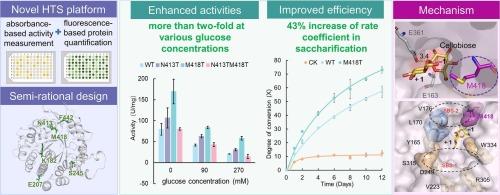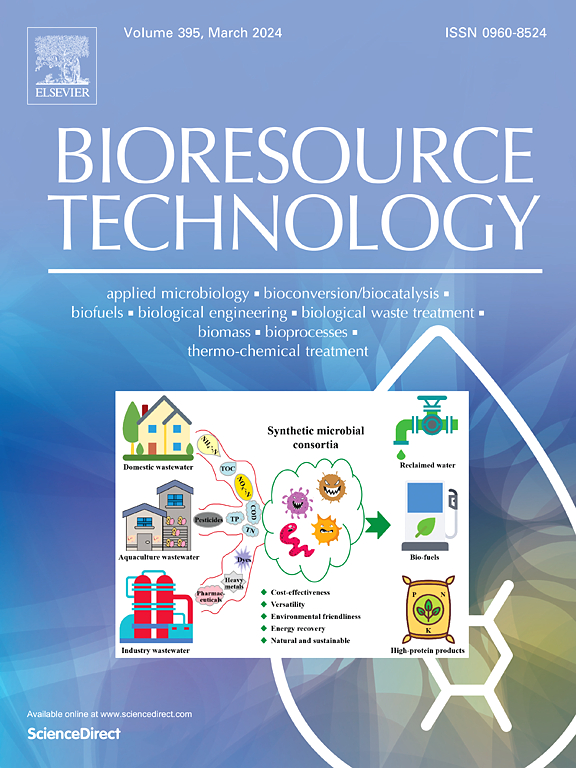改善纤维素水解性能的β-葡萄糖苷酶CaBGL工程研究。
IF 9
1区 环境科学与生态学
Q1 AGRICULTURAL ENGINEERING
引用次数: 0
摘要
β-葡萄糖苷酶(β-Glucosidase, BGL)通过减轻纤维素酶对纤维素酶的抑制作用,在木质纤维素的利用中起着至关重要的作用。从Caldicellulosiruptor sp. F32 (CaBGL)中加入BGL提高了固结生物糖化过程的整体效率。为了优化工业条件下BGL的性能,我们建立了一个基于耐热绿色荧光蛋白的高通量筛选平台,结合结构知情的半理性设计,使功能增强的CaBGL突变体得以产生。这种方法鉴定出突变体M418T,在不同浓度的葡萄糖缺失和存在下,与野生型相比,M418T表现出两倍以上的催化活性。体外纤维素糖化实验表明,与野生型相比,M418T的糖化率系数提高了43.27 %。通过结构分析和分子对接进一步阐明了其性能改善的机制。因此,这项工作提出了一种有效的方法来提高CaBGL的性能,并展示了一种有前途的催化剂在木质纤维素转化中的潜力。本文章由计算机程序翻译,如有差异,请以英文原文为准。

Engineering of β-glucosidase CaBGL with improved performance in cellulose hydrolysis
β-Glucosidase (BGL) plays a crucial role in lignocellulose utilization by alleviating cellobiose inhibition of cellulases. Incorporation of the BGL from Caldicellulosiruptor sp. F32 (CaBGL) enhanced the overall efficiency of the consolidated bio-saccharification process. To optimize BGL performance under industrial conditions, we established a thermostable green fluorescent protein-based high-throughput screening platform coupled with structure-informed semi-rational design, enabling the generation of functionally enhanced CaBGL mutants. This approach identified mutant M418T, which exhibited more than two-fold catalytic activity compared to that of wild type in both the absence and presence of glucose at various concentrations. In vitro cellulose saccharification showed that M418T increased the saccharification rate coefficient by 43.27 % compared to the wild-type. The mechanisms underlying its improved property were further elucidated through structural analysis and molecular docking. Consequently, this work presents an effective approach for enhancing the performance of CaBGL and demonstrates the potential of a promising catalyst in lignocellulose conversion.
求助全文
通过发布文献求助,成功后即可免费获取论文全文。
去求助
来源期刊

Bioresource Technology
工程技术-能源与燃料
CiteScore
20.80
自引率
19.30%
发文量
2013
审稿时长
12 days
期刊介绍:
Bioresource Technology publishes original articles, review articles, case studies, and short communications covering the fundamentals, applications, and management of bioresource technology. The journal seeks to advance and disseminate knowledge across various areas related to biomass, biological waste treatment, bioenergy, biotransformations, bioresource systems analysis, and associated conversion or production technologies.
Topics include:
• Biofuels: liquid and gaseous biofuels production, modeling and economics
• Bioprocesses and bioproducts: biocatalysis and fermentations
• Biomass and feedstocks utilization: bioconversion of agro-industrial residues
• Environmental protection: biological waste treatment
• Thermochemical conversion of biomass: combustion, pyrolysis, gasification, catalysis.
 求助内容:
求助内容: 应助结果提醒方式:
应助结果提醒方式:


